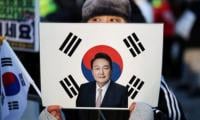Civil society protests against religious extremism
KarachiWorn out after a long day’s work, a large number of city’s ordinary dwellers, otherwise disassociated with the country’s politics, gathered at the Teen Talwar intersection on Monday to protest against the continuous intelligence failures and the lacklustre response of state authorities to protect its citizens from one terrorist attack
By Fatima Zaidi
February 17, 2015
Karachi
Worn out after a long day’s work, a large number of city’s ordinary dwellers, otherwise disassociated with the country’s politics, gathered at the Teen Talwar intersection on Monday to protest against the continuous intelligence failures and the lacklustre response of state authorities to protect its citizens from one terrorist attack after the other.
From those belonging to the upper class to those coming from economically-deprived backgrounds, all stood against religious extremism and demanded from the state authorities to get their house in order.
The civil society’s movement against religious fundamentalism which began after the sit-in outside the CM House following the Shikarpur Imambargah blast, although still at a nascent stage, gained momentum after around 22 protestors demanding action against the banned religious outfit Ahl-e-Sunnat Wal Jamaat (ASWJ) were arrested from outside the CM House on charges of violence in the Red Zone on February 5. Simultaneously, the ASWJ has also staged an unscheduled sit-in, within the protection of the party’s guards armed with sophisticated weapons, on the other side of the containers placed to block the entrance to the CM House.
The protestors, comprising Sindhi nationalists, leftists, rightists and people following populist narratives, stood united against the cause and chanted slogans condemning religious fundamentalism. However, the strategies suggested for ridding the country of violence varied due to the difference in the schools of thought.
Social activist Khurram Zaki while speaking to The News agreed to the differing narratives of the protestors. He said there was indeed a war between two narratives within the civil society, but it was nonetheless a peoples’ movement.
“There is a need to link the state up with religious terrorism. The violence has to end and all victim communities need to stand together, or else we would never be able to wipe this menace out,” he said.
National Students Federation Pakistan’s central organiser Khurram Ali said, “The State has to stop aiding sectarian outfits and should seal their offices. It has to change its tactics of using these outfits in Balochistan, Sindh and as well as Kashmir.”
He was of the opinion that people would continue to suffer till all support to the Haqqani network was rescinded. “The state needs to stop differentiating between the Good and the Bad Taliban; not by mere words but by actions too.”
Pakistan Institute of Labour Education and Research representative Aabida Ali said it was the state’s responsibility to protect its citizens but banned religious outfits publicly held rallies outside the Supreme Court and chanted slogans against the Shia community while the State authorities looked on. “Where is the state’s writ?” she asked.
Lamenting the Sindh government for arresting peaceful civil society members protesting against providing the ASWJ chief security protocol right after agreeing to withdraw it, and them permitting the organisation to stage a rally after acceding to the protestors’ demands to seal their offices, she said, “It was clear that the state’s allegiance certainly did not lie with its ordinary citizens.”
“There is no debating the fact that these banned outfits are targeting Shias with impunity. But we have gathered here as the voice of all those who became victims of terrorism,” said Shahryar Naqvi, one of the protestors. Sceptical of the differing point of views, another protestor Asna Qureshi while emphasising on the importance of a civil society movement said, “It had to be now or else nobody would ever speak for more than the 50,000 innocent victims of war.”
Worn out after a long day’s work, a large number of city’s ordinary dwellers, otherwise disassociated with the country’s politics, gathered at the Teen Talwar intersection on Monday to protest against the continuous intelligence failures and the lacklustre response of state authorities to protect its citizens from one terrorist attack after the other.
From those belonging to the upper class to those coming from economically-deprived backgrounds, all stood against religious extremism and demanded from the state authorities to get their house in order.
The civil society’s movement against religious fundamentalism which began after the sit-in outside the CM House following the Shikarpur Imambargah blast, although still at a nascent stage, gained momentum after around 22 protestors demanding action against the banned religious outfit Ahl-e-Sunnat Wal Jamaat (ASWJ) were arrested from outside the CM House on charges of violence in the Red Zone on February 5. Simultaneously, the ASWJ has also staged an unscheduled sit-in, within the protection of the party’s guards armed with sophisticated weapons, on the other side of the containers placed to block the entrance to the CM House.
The protestors, comprising Sindhi nationalists, leftists, rightists and people following populist narratives, stood united against the cause and chanted slogans condemning religious fundamentalism. However, the strategies suggested for ridding the country of violence varied due to the difference in the schools of thought.
Social activist Khurram Zaki while speaking to The News agreed to the differing narratives of the protestors. He said there was indeed a war between two narratives within the civil society, but it was nonetheless a peoples’ movement.
“There is a need to link the state up with religious terrorism. The violence has to end and all victim communities need to stand together, or else we would never be able to wipe this menace out,” he said.
National Students Federation Pakistan’s central organiser Khurram Ali said, “The State has to stop aiding sectarian outfits and should seal their offices. It has to change its tactics of using these outfits in Balochistan, Sindh and as well as Kashmir.”
He was of the opinion that people would continue to suffer till all support to the Haqqani network was rescinded. “The state needs to stop differentiating between the Good and the Bad Taliban; not by mere words but by actions too.”
Pakistan Institute of Labour Education and Research representative Aabida Ali said it was the state’s responsibility to protect its citizens but banned religious outfits publicly held rallies outside the Supreme Court and chanted slogans against the Shia community while the State authorities looked on. “Where is the state’s writ?” she asked.
Lamenting the Sindh government for arresting peaceful civil society members protesting against providing the ASWJ chief security protocol right after agreeing to withdraw it, and them permitting the organisation to stage a rally after acceding to the protestors’ demands to seal their offices, she said, “It was clear that the state’s allegiance certainly did not lie with its ordinary citizens.”
“There is no debating the fact that these banned outfits are targeting Shias with impunity. But we have gathered here as the voice of all those who became victims of terrorism,” said Shahryar Naqvi, one of the protestors. Sceptical of the differing point of views, another protestor Asna Qureshi while emphasising on the importance of a civil society movement said, “It had to be now or else nobody would ever speak for more than the 50,000 innocent victims of war.”
-
 North West Raps About Piercings, Tattoos And Skipping School In New Song
North West Raps About Piercings, Tattoos And Skipping School In New Song -
 Teddi Mellencamp Shares Hopeful Health Update Amid Cancer Battle: 'Cloud Is Lifting'
Teddi Mellencamp Shares Hopeful Health Update Amid Cancer Battle: 'Cloud Is Lifting' -
 Prince William Makes Clear The Conditions He Has For Meeting Prince Harry
Prince William Makes Clear The Conditions He Has For Meeting Prince Harry -
 Sara Foster Slams Age Gap Relationship After 'blah' George Clooney Date
Sara Foster Slams Age Gap Relationship After 'blah' George Clooney Date -
 Jennifer Garner Recalls Enduring Ben Affleck’s Intense Beyoncé ‘Halo’ Phase
Jennifer Garner Recalls Enduring Ben Affleck’s Intense Beyoncé ‘Halo’ Phase -
 Prince Harry’s Mental Health Ends Up At Stake As Meghan Moves Him To 'second Fiddle'
Prince Harry’s Mental Health Ends Up At Stake As Meghan Moves Him To 'second Fiddle' -
 Bradley Cooper On Who His Mother Thinks Is The World’s Best Actor
Bradley Cooper On Who His Mother Thinks Is The World’s Best Actor -
 Meghan Markle Offers Glimpse Into Intimate Dance Moment With Harry Amid Split Rumors
Meghan Markle Offers Glimpse Into Intimate Dance Moment With Harry Amid Split Rumors -
 Jon Bon Jovi Joins The Viral 2016 Throwback Trend With Nostalgic Photos
Jon Bon Jovi Joins The Viral 2016 Throwback Trend With Nostalgic Photos -
 Kate Middleton Hailed For Her Lack Of ‘obligation’ As Well As Altruistic, Selfless Qualities
Kate Middleton Hailed For Her Lack Of ‘obligation’ As Well As Altruistic, Selfless Qualities -
 Jason Momoa Says Being With Beau Adria Arjona Feels 'perfect'
Jason Momoa Says Being With Beau Adria Arjona Feels 'perfect' -
 Idris Elba Says One Mix-up Nearly Cost Him A Knighthood From King Charles
Idris Elba Says One Mix-up Nearly Cost Him A Knighthood From King Charles -
 Andrew Mountbatten Windsor Incurs Anger Of Biggest Royal
Andrew Mountbatten Windsor Incurs Anger Of Biggest Royal -
 Megan Fox, Machine Gun Kelly's Relationship 'is Just About Co-parenting'
Megan Fox, Machine Gun Kelly's Relationship 'is Just About Co-parenting' -
 Prince Harry, Meghan Markle Warned They Can’t Fool Brits Because It Won’t Land
Prince Harry, Meghan Markle Warned They Can’t Fool Brits Because It Won’t Land -
 South Korea’s Ex-president Yoon Suk Yeol, Sentenced To 5 Years In Prison: Key Details Explained
South Korea’s Ex-president Yoon Suk Yeol, Sentenced To 5 Years In Prison: Key Details Explained



